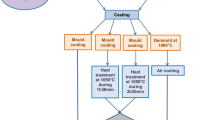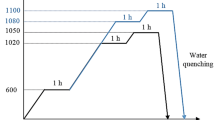Abstract
In this study, the effect of melting temperature on the microstructural evolutions, behavior, and corrosion morphology of Hadfield steel in the casting process is investigated. The mold was prepared by the sodium silicate/CO2 method, using a blind riser, and then the desired molten steel was obtained using a coreless induction furnace. The casting was performed at melting temperatures of 1350, 1400, 1450, and 1500°C, and the cast blocks were immediately quenched in water. Optical microscopy was used to analyze the microstructure, and scanning electron microscopy (SEM) and X-ray diffractrometry (XRD) were used to analyze the corrosion morphology and phase formation in the microstructure, respectively. The corrosion behavior of the samples was analyzed using a potentiodynamic polarization test and electrochemical impedance spectroscopy (EIS) in 3.5wt% NaCl. The optical microscopy observations and XRD patterns show that the increase in melting temperature led to a decrease of carbides and an increase in the austenite grain size in the Hadfield steel microstructure. The corrosion tests results show that with increasing melting temperature in the casting process, Hadfield steel shows a higher corrosion resistance. The SEM images of the corrosion morphologies show that the reduction of melting temperature in the Hadfield steel casting process induced micro-galvanic corrosion conditions.
Similar content being viewed by others
References
L. Ma, C. Huang, K. Dolman, X.H. Tang, J.J. Yang, Z. Shi, and Z.S. Liu, A method to calculate the bulk hardness of metal matrix composite using Hadfield steel reinforced with niobium carbide particles as an example, Mech. Mater., 112(2017), p. 154.
C. Chen, X.Y. Feng, B. Lv, Z.N. Yang, and F.C. Zhang, A study on aging carbide precipitation behavior of hadfield steel by dynamic elastic modulus, Mater. Sci. Eng. A, 677(2016), p. 446.
D.V. Lychagin, A.V. Filippov, O.S. Novitskaia, Y.I. Chumlyakov, E.A. Kolubaev, and O.V. Sizova, Friction–induced slip band relief of–Hadfield steel single crystal oriented for multiple slip deformation, Wear, 374(2017), p. 5.
C. Chen, F.C. Zhang, F. Wang, H. Liu, and B.D. Yu, Effect of N+Cr alloying on the microstructures and tensile properties of Hadfield steel, Mater. Sci. Eng. A, 679(2017), p. 95.
S.F. Gnyusov, V.P. Rotshtein, A.E. Mayer, E.G. Astafurova, V.V. Rostov, A.V. Gunin, and G.G. Maier, Comparative study of shock–wave hardening and substructure evolution of 304L and Hadfield steels irradiated with a nanosecond relativistic high–current electron beam, J. Alloys Compd., 714(2017), p. 232.
J.T. Horng and K.T. Chiang, A grey and fuzzy algorithms integrated approach to the optimization of turning Hadfield steel with Al2O3/TiC mixed ceramic tool, J. Mater. Process. Technol., 207(2008), No. 1–3, p. 89.
I. Mejía, A.E. Salas–Reyes, J. Calvo, and J.M. Cabrera, Effect of Ti and B microadditions on the hot ductility behavior of a high–Mn austenitic Fe−23Mn−1.5Al−1.3Si−0.5C TWIP steel, Mater. Sci. Eng. A, 648(2015), p. 311.
D. Siafakas, T. Matsushita, Å. Lauenstein, S. Ekero, and A.E.W. Jarfors, A particle population analysis in Ti–and Al–deoxidized Hadfield steels, Int. J. Cast Met. Res., 31(2018), No. 3, p. 125.
A.K. Srivastava and K. Das, In–situ synthesis and characterization of TiC–reinforced Hadfield manganese austenitic steel matrix composite, ISIJ Int., 49(2009), No. 9, p. 1372.
A.K. Srivastava, K. Das, and S.K. Toor, Corrosion behaviour of TiC–reinforced Hadfield manganese austenitic steel matrix in–situ composites, Open J. Met. 5(2015), No. 2, p. 11.
X.Y. Feng, F.C. Zhang, Z.N. Yang, and M. Zhang, Wear behaviour of nanocrystallised Hadfield steel, Wear, 305(2013), No. 1–2, p. 299.
G.S. Zhang, J.D. Xing, and Y.M. Gao, Impact wear resistance of WC/Hadfield steel composite and its interfacial characteristics. Wear, 260(2006), No. 7–8, p. 728.
W.L. Yan, L. Fang, K. Sun, and Y.H. Xu, Effect of surface work hardening on wear behavior of Hadfield steel, Mater. Sci. Eng. A, 460(2007), p. 542.
Y.N. Dastur and W.C. Leslie, Mechanism of work hardening in Hadfield manganese steel, Metall. Trans. A, 12(1981), No. 5, p. 749.
S. Hofer, M. Hartl, G. Schestak, R. Schneider, E. Arenholz, and L. Samek, Comparison of austenitic high–Mn–steels with different Mn–and C–contents regarding their processing properties, BHM Berg–Huttenmann. Monatsh., 156(2011), No. 3, p. 99.
S.M. Anijdan, M. Sabzi, M. Ghobeiti–Hasab, and A. Roshan–Ghiyas, Optimization of spot welding process parameters in dissimilar joint of dual phase steel DP600 and AISI 304 stainless steel to achieve the highest level of shear–tensile strength, Mater. Sci. Eng. A, 726(2018), p. 120.
C. Iglesias, I.G. Solórzano, and B.J. Schulz, Effect of low nitrogen content on work hardening and microstructural evolution in Hadfield steel, Mater Charact., 60(2009), No. 9, p. 971.
T. Kıvak, Optimization of surface roughness and flank wear using the Taguchi method in milling of Hadfield steel with PVD and CVD coated inserts, Measurement, 50(2014), p. 19.
E. Bayraktar, F.A. Khalid, and C. Levaillant, Deformation and fracture behaviour of high manganese austenitic steel, J. Mater. Process. Technol., 147(2004), No. 2, p. 145.
D. Canadinc, H. Sehitoglu, and H.J. Maier, The role of dense dislocation walls on the deformation response of aluminum alloyed Hadfield steel polycrystals, Mater. Sci. Eng. A, 454(2007), p. 662.
S.H.M. Anijdan and M. Sabzi, The evolution of microstructure of an high Ni HSLA X100 forged steel slab by thermomechanical controlled processing, [in] TMS Annual Meeting & Exhibition, Cham, 2018, p. 145.
I. Karaman, H. Sehitoglu, Y.I. Chumlyakov, H.J. Maier, and I.V. Kireeva, Extrinsic stacking faults and twinning in Hadfield manganese steel single crystals, Scr. Mater., 44(2001), No. 2, p. 337.
D. Canadinc, H. Sehitoglu, H.J. Maier, and Y.I. Chumlyakov, Strain hardening behavior of aluminum alloyed Hadfield steel single crystals, Acta Mater., 53(2005), No. 6, p. 1831.
M. Sabzi, A. Obeydavi, and S.H.M. Anijdan, The effect of joint shape geometry on the microstructural evolution, fracture toughness, and corrosion behavior of the welded joints of a Hadfield steel, Mech. Adv. Mater. Struct., (2018), p. 1. https://doi.org/10.1080/15376494.2018.1430268.
S. Hosseini and M.B. Limooei, Optimization of heat treatment to obtain desired mechanical properties of high carbon Hadfield steels, World Appl. Sci. J., 15(2011), No. 10, p. 1421.
S. Hosseini, M.B. Limooei, M.H. Zade, E. Askarnia, and Z. Asadi, Optimization of heat treatment due to austenising temperature, time and quenching solution in Hadfield steels, Int. J. Chem. Mol. Nucl. Mater. Metall. Eng., 7(2013), No. 7, p. 582.
I.U.H. Toor, Effect of Mn content and solution annealing temperature on the corrosion resistance of stainless steel alloys, J. Chem., 2014(2014), p. 1.
Y.K. Lee and C.S. Choi, Driving force for γ→ε martensitic transformation and stacking fault energy of γ in Fe−Mn binary system, Metall. Mater. Trans. A, 31(2000), No. 2, p. 355.
T.E. Abioye, P.K. Farayibi, D.G. McCartney, and A.T. Clare, Effect of carbide dissolution on the corrosion performance of tungsten carbide reinforced Inconel 625 wire laser coating, J. Mater. Process. Technol., 231(2016), p. 89.
S.H.M. Anijdan, M. Sabzi, M.R. Zadeh, and M. Farzam, The effect of electroless bath parameters and heat treatment on the properties of Ni−P and Ni−P−Cu composite coatings, Mater. Res., 21(2018), No. 2, p. 1.
J. Li, J.S. Wu, Z. Wang, S.Q. Zhang, X.G. Wu, Y.H. Huang, and X.G. Li, The effect of nanosized NbC precipitates on electrochemical corrosion behavior of high–strength low–alloy steel in 3.5% NaCl solution, Int. J. Hydrogen Energy, 42(2017), No. 34, p. 22175.
J. Sanchez, J. Fullea, and C. Andrade, Corrosion–induced brittle failure in reinforcing steel, Theor. Appl. Fract. Mech., 92(2017), p. 229.
T.R. Tamilarasan, U. Sanjith, M.S. Shankar, and G. Rajagopal, Effect of reduced graphene oxide (rGO) on corrosion and erosion–corrosion behaviour of electroless Ni−P coatings, Wear, 390 (2017), p. 385.
D.J. Blackwood, C.S. Lim, S.L.M. Teo, X.P. Hu, and J.J. Pang, Macrofouling induced localized corrosion of stainless steel in Singapore seawater, Corros. Sci., 129(2017), p. 152.
J.H. Hong, S.H. Lee, J.G. Kim, and J.B. Yoon, Corrosion behaviour of copper containing low alloy steels in sulphuric acid, Corros. Sci., 54(2012), p. 174.
R.Q. Hou, C.Q. Ye, C.D. Chen, S.G. Dong, M.Q. Lv, S. Zhang, J.S. Pan, G.L. Song, and C.J. Lin, Localized corrosion of binary Mg−Ca alloy in 0.9wt% sodium chloride solution, Acta Metall. Sinica (Engl. Lett.), 29(2016), No. 1, p. 46.
M.L.C. Lim, R.G. Kelly, and J.R. Scully, Overview of intergranular corrosion mechanisms, phenomenological observations, and modeling of AA5083, Corros. Sci., 72(2016), No. 2, p. 198.
M. Sabzi, S.H.M. Anijdan, and M. Asadian, The effect of substrate temperature on microstructural evolution and hardenability of tungsten carbide coating in hot filament chemical vapor deposition, Int. J. Appl. Ceram. Technol., 15(2018), No. 6, p. 1350.
S.M. Dezfuli and M. Sabzi, A study on the effect of presence of CeO2 and benzotriazole on activation of self–healing mechanism in ZrO2 ceramic–based coating, Int. J. Appl. Ceram. Technol., 15(2018), No. 5, p. 1248.
M. Sabzi, S.H.M. Anijdan, M.R. Zadeh, and M. Farzam, The effect of heat treatment on corrosion behaviour of Ni−P−3 gr/lit Cu nano–composite coating, Can. Metall. Q., 57(2018), No. 3, p. 350.
Author information
Authors and Affiliations
Corresponding author
Rights and permissions
About this article
Cite this article
Sabzi, M., Far, S.M. & Dezfuli, S.M. Effect of melting temperature on microstructural evolutions, behavior and corrosion morphology of Hadfield austenitic manganese steel in the casting process. Int J Miner Metall Mater 25, 1431–1438 (2018). https://doi.org/10.1007/s12613-018-1697-1
Received:
Revised:
Accepted:
Published:
Issue Date:
DOI: https://doi.org/10.1007/s12613-018-1697-1




